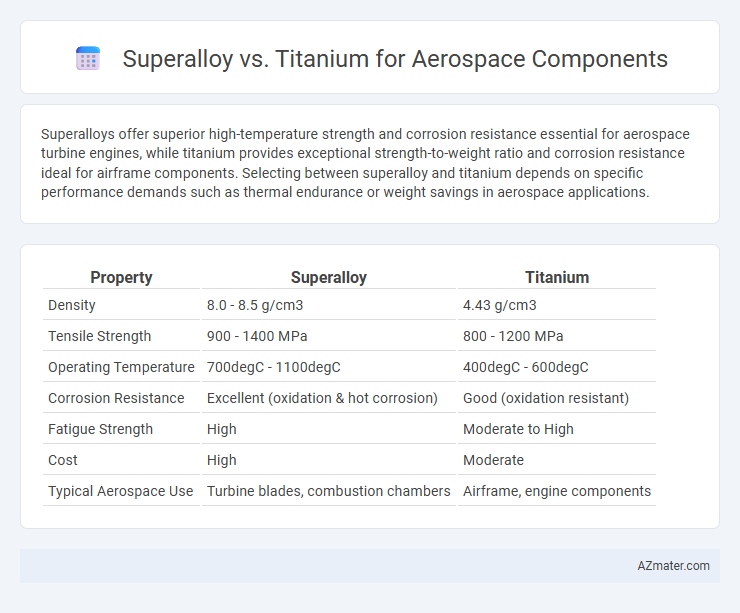Superalloys offer superior high-temperature strength and corrosion resistance essential for aerospace turbine engines, while titanium provides exceptional strength-to-weight ratio and corrosion resistance ideal for airframe components. Selecting between superalloy and titanium depends on specific performance demands such as thermal endurance or weight savings in aerospace applications.
Table of Comparison
| Property | Superalloy | Titanium |
|---|---|---|
| Density | 8.0 - 8.5 g/cm3 | 4.43 g/cm3 |
| Tensile Strength | 900 - 1400 MPa | 800 - 1200 MPa |
| Operating Temperature | 700degC - 1100degC | 400degC - 600degC |
| Corrosion Resistance | Excellent (oxidation & hot corrosion) | Good (oxidation resistant) |
| Fatigue Strength | High | Moderate to High |
| Cost | High | Moderate |
| Typical Aerospace Use | Turbine blades, combustion chambers | Airframe, engine components |
Introduction to Aerospace Material Selection
Superalloys and titanium alloys are critical materials in aerospace component manufacturing due to their exceptional strength-to-weight ratios and corrosion resistance. Superalloys excel in high-temperature environments such as turbine engines, maintaining mechanical integrity above 900degC, while titanium alloys provide superior strength and fatigue resistance at significantly lower densities, ideal for airframe structures. Material selection hinges on application-specific conditions like thermal exposure, mechanical stress, and weight constraints to optimize performance and durability in aerospace designs.
Overview of Superalloys in Aerospace Applications
Superalloys, primarily composed of nickel, cobalt, or iron, offer exceptional high-temperature strength, corrosion resistance, and creep resistance, making them indispensable for critical aerospace components such as turbine blades, combustion chambers, and jet engine parts. Their ability to maintain mechanical integrity under extreme thermal and oxidative environments surpasses that of titanium alloys, which are favored for lower temperature structural parts due to their excellent strength-to-weight ratio and corrosion resistance. The enhanced high-temperature performance of superalloys ensures reliability and longevity in harsh aerospace conditions, driving their widespread adoption in engine and propulsion system manufacturing.
Titanium Alloys: Properties and Usage
Titanium alloys are prized in aerospace components for their exceptional strength-to-weight ratio, corrosion resistance, and high-temperature performance, making them ideal for critical structural parts and engine components. These alloys maintain mechanical integrity at temperatures up to 600degC, outperforming many traditional metals, and offer greater fatigue resistance under cyclic loading conditions. Common aerospace titanium alloys like Ti-6Al-4V are extensively used in airframes, landing gear, and turbine engine components due to their superior performance and weight reduction capabilities compared to superalloys.
Mechanical Strength Comparison: Superalloy vs Titanium
Superalloys exhibit superior mechanical strength at elevated temperatures, maintaining high creep resistance and fatigue endurance essential for aerospace engine components operating under extreme thermal and stress conditions. Titanium alloys offer a high strength-to-weight ratio with excellent corrosion resistance but generally have lower high-temperature strength compared to superalloys, making them more suitable for airframe structures rather than turbine blades. The mechanical strength advantage of superalloys over titanium is critical in aerospace applications requiring sustained performance above 600degC, where titanium strength rapidly declines.
Corrosion and Oxidation Resistance
Superalloys exhibit exceptional corrosion and oxidation resistance due to their high nickel, cobalt, or iron content alloyed with chromium and aluminum, forming protective oxide layers that withstand extreme aerospace environments. Titanium offers excellent corrosion resistance, particularly in oxidizing atmospheres, thanks to its stable titanium oxide film, but it is less resistant to high-temperature oxidation compared to superalloys. In aerospace components exposed to high temperatures and aggressive oxidative conditions, superalloys outperform titanium by maintaining structural integrity and resistance to environmental degradation.
Weight Considerations in Aerospace Design
Superalloys offer exceptional strength and temperature resistance for critical aerospace components but are significantly denser than titanium, impacting overall aircraft weight. Titanium's high strength-to-weight ratio and corrosion resistance make it ideal for reducing structural weight while maintaining performance and durability. Weight considerations in aerospace design often favor titanium to optimize fuel efficiency and increase payload capacity without compromising component integrity.
Heat Resistance and Performance at High Temperatures
Superalloys, primarily nickel-based, exhibit exceptional heat resistance and maintain mechanical strength at temperatures exceeding 1000degC, making them ideal for aerospace turbine components exposed to extreme thermal stress. Titanium alloys, while lighter and offering good corrosion resistance, typically perform effectively up to around 600degC and are favored for structural parts requiring high strength-to-weight ratios but less thermal exposure. The superior high-temperature stability of superalloys ensures better durability and performance in critical engine applications where maintaining integrity under intense heat is crucial.
Manufacturing and Machinability Differences
Superalloys offer exceptional high-temperature strength and corrosion resistance, making them ideal for turbine blades and engine components, but their manufacturing involves complex casting and heat treatment processes, which increase production time and cost. Titanium, favored for its lightweight properties and excellent strength-to-weight ratio, enables faster machining and easier fabrication due to its excellent machinability and lower melting point. While superalloys require specialized tooling and slower cutting speeds because of their hardness, titanium allows efficient manufacturing with reduced tool wear, making it suitable for structural aerospace parts that demand both performance and manufacturability.
Cost Analysis: Superalloy vs Titanium
The cost analysis of superalloy versus titanium for aerospace components reveals superalloys generally have a lower initial material cost but incur higher manufacturing expenses due to complex machining and heat treatment requirements. Titanium, while more expensive in raw material price, offers reduced processing costs attributed to its machinability and corrosion resistance, resulting in longer lifecycle savings. Maintenance and lifecycle cost considerations typically favor titanium in high-performance aerospace applications despite the premium upfront investment.
Choosing the Optimal Material for Aerospace Components
Superalloys provide exceptional high-temperature strength and oxidation resistance, making them ideal for turbine blades and engine components in aerospace applications. Titanium offers a superior strength-to-weight ratio and excellent corrosion resistance, which is critical for airframe structures and fasteners. Selecting the optimal material depends on balancing factors such as operating temperature, mechanical stress, weight constraints, and environmental exposure to maximize performance and durability in aerospace components.

Infographic: Superalloy vs Titanium for Aerospace Component
 azmater.com
azmater.com